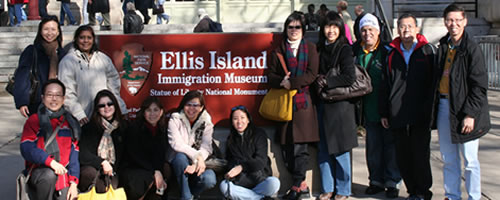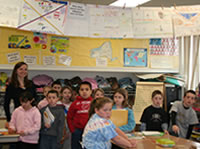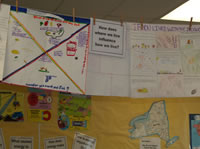Why Singapore’s English Teachers Should Embrace Singlish, Not Fight It
Is it time for Singaporean educators to embrace Singlish as a legitimate learning tool? What the Research […]
Read More
During the end-of-year semester break last year, 12 educators from the North Zone spent 11 days traversing across 4 American states in 3 cars. Their mission was to see how schools in the United States were implementing innovative ways of teaching and learning. SingTeach caught up with 4 of the participants to find out more.

Sitting in a room with these four educators, barely 2 months after their return, one cannot help but feel their sense of energy and excitement. With their US trip still fresh in their minds, their enthusiasm and conviction are contagious.
This study trip was initiated by the leaders of Xinmin Secondary School. As one of the prototype schools selected by the Ministry of Education under the Teach Less, Learn More initiative to bring about school-based curriculum innovations, Xinmin was keen to adopt Wiggins and McTighe’s Understanding by Design (UbD) model as a framework for their school’s curriculum and see how it was being applied in the US.
It soon became a zone project, with 6 principals and 5 heads of department from the North Zone on board. “The zone’s focus was also to level up school leaders’ capacity in curriculum leadership, and this was part of the efforts to work on that,” explains Ms Grace Ng, Superintendent of the North 1 Cluster, who was also on the trip.
 The group observed classes and talked to fellow educators in 11 schools in New York, New Jersey, Washington DC and Philadelphia.
The group observed classes and talked to fellow educators in 11 schools in New York, New Jersey, Washington DC and Philadelphia.
“It was like an epiphany,” says William Grosse, who teaches Rosyth School’s Gifted Education (GE) Programme. “I’ve dealt with UbD in the GE, but I didn’t really understand what teaching for understanding meant until I saw the things that happened in the American classrooms. Then things clicked.”
For Ms Ng Siew Chin, Xinmin’s Science Head, the “experiential learning” was invaluable. “When I went there, I saw for myself how the teachers delivered the lesson and how they engaged the students in the learning. It made me question myself, why I teach the subject Chemistry.”
“It was useful to see the varying degrees of successful implementation in the different schools and districts, and to figure out what we must be careful about, what we must do, what we must not do, and so on,” adds Xinmin’s Principal, Mdm Liew Wei Li.
As a pedagogical approach, UbD is not new. In fact, it is one of many approaches that has already been implemented by several schools in Singapore. So, what is UbD anyway?
 “It’s not so much a different way of teaching,” explains Wei Li. “I would say it’s an awakening of the teacher, because you become so aware of what the priorities are, what is important to emphasise.”
“It’s not so much a different way of teaching,” explains Wei Li. “I would say it’s an awakening of the teacher, because you become so aware of what the priorities are, what is important to emphasise.”
In practice, UbD offers a 3-stage “backward planning” curriculum design process. Stage 1 begins with identifying the desired results; followed by Stage 2, where you determine acceptable evidence of Stage 1; and finally, at Stage 3, you plan the learning experiences and instruction.
“I think because UbD makes you stare at this thing called understanding in the eye and come to terms with it,” notes William. “Basically, that’s what we’re supposed to aim for in school – understanding. We’re not supposed to just aim for academic results or awards – we’re supposed to aim for understanding. And to bring understanding by design – bringing understanding through intention!”
After each school visit, the group would spend time reflecting together about what they had seen and heard.
“What I realised was that the process is all-important,” shares William. “When I went to the States, I could actually get a sense of the teachers grappling with it. And when I listened to the conversations, to the teachers explaining their frustrations and anxieties, or their own feelings and questions as they went about grappling with the programme, I realised I was missing that – the conversations, the growth, the development, the grappling with the issues – not just the curriculum but the issues that come about because you grapple with the curriculum and because you grapple with UbD.”
Siew Chin agrees. “I think it’s a process that is very critical for the teachers to go through when planning our lessons, because it makes you first look at how and why you teach, and how you can interlink the topics into one big theme so that students can understand that all are integrated.”
Call it what you will – a framework, an approach, or “a way of thinking” (according to William) – and debate it all you want, for these educators, the study trip has certainly given new meaning to what it means to teach for understanding.
Says Siew Chin, “It has actually changed the way I look at my unit plans now, and I try to bring the ‘why’ to the students .Why do they have to know this? Does it relate to them? Is it important to them?”
“UbD has made me think more carefully about how I want to approach my teaching,” says William. “I actually talk to my kids about it, and I even approach my grammar lessons through misunderstandings, which is something you do in UbD – identify a misunderstanding, and then teach around it.”
He admits that “it’s made life a bit more difficult, because I have to redo my work – I have to look at my worksheets and then redo them.” It has been an “intellectually stressful” process, but he is quick to add that “it’s good stress, because it makes you think about your teaching.”
“I think one of the greatest advantages is that UbD helps the kids to find meaning in what they do and what the teacher is trying to do, so they relate to a bigger whole rather than just the compartmentalised lessons,” adds Grace. “It makes teaching more meaningful, and teaching and learning become more real, for both the kids and for the teachers. You don’t just teach what is there in the text – you relate it to life and you relate it to bigger ideas, and that in itself is energising. You teach it because there are deeper understandings that you want to grapple with.”
But, is UbD really viable in our classrooms?
“I think it is feasible,” says Grace. “Because if you look at the essence of it all, and if the teachers believe in the essence of it all, it’s a matter of customising your lessons to ensure that you deliver what you’re supposed to be delivering – and that is to help the kids relate to a bigger picture in life.”
The trip has helped to kickstart the process of curriculum innovation at Xinmin. As this is a school-wide initiative, all their teachers are currently being trained in UbD. They are working together on curriculum design, grappling with the curriculum as a whole, asking themselves fundamental questions about why they are teaching each topic, and looking for links between topics.
Before the year is up, each department would have tried to redesign and teach at least one unit, in all the streams.
“The whole process of UbD – actually one of the biggest benefits – is in helping each teacher to become more effective, and increasing his capacity,” explains Wei Li. “It’s not so much just having an engaging lesson, but it is more sustainable because it is the teacher who would have been raised in his capacity. I can’t wait to see, after the end of maybe 4 years, how each teacher teaches differently and sees his role and himself differently.”
In terms of implementation, the factors to consider, says Wei Li, are “resources, the readiness of your teachers, and whether you yourself are willing to put in that investment yourself, because UbD is something that the leader has to roll up the sleeves and do, too. It doesn’t work any other way.” “And time is very essential,” adds Siew Chin, “time given to the teachers to be able to dialogue, converse and reflect after each lesson.”
“I think at the end of the day, the trip served this purpose at least – it got the participants to see for themselves the feasibility of implementation,” notes Grace. “At the end of the day, if they decide that their school is not ready for it, then that’s fine. But at least it helped them to grapple with some of the critical issues that they cannot omit in the implementation. They have picked up important aspects of curriculum leadership”
For William, the real road trip has only just begun. He is currently mentoring a few of his fellow teachers in the use of UbD and challenging them to approach their teaching differently. “Some people think it’s for bright learners. It’s for everyone – that’s what I really believe,” says William. “It really places the teacher not on a pedestal but at the core of teaching. It’s not the curriculum – it’s the teacher.”
So, as William would say, “UbD or not?”
> Want to know how UbD can be used in the NT classroom? Click here.